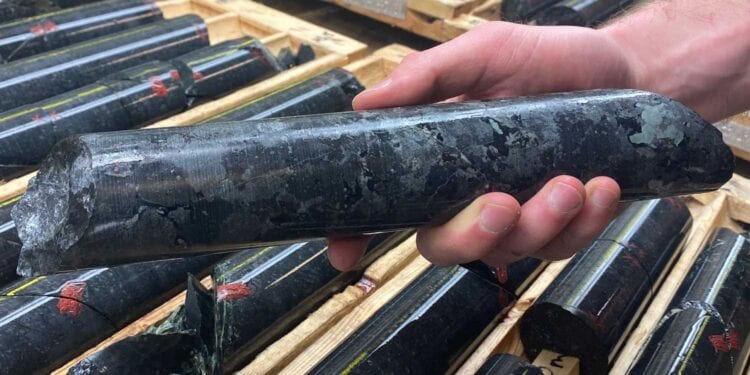Records Substantial Improvement In Metallurgical Performance
Canada Nickel Company Inc. (TSXV: CNC) (OTCQX: CNIKF) has obtained substantial metallurgical improvements that deliver increased recoveries of nickel, iron and cobalt, as well as enhanced iron magnetite concentrate quality, at its 100% owned Crawford Nickel Sulphide Project in Ontario.
“I am very pleased with this step change in metallurgical performance that our team has unlocked during this phase of flowsheet optimisation,” Chair and CEO, Mark Selby, said.
“The nickel recovery is substantially higher than the 4-5 percentage point improvement in nickel recovery the Company is targeting for the feasibility study. The improvement in grade and recovery of iron in the magnetite concentrate that has already been unlocked is excellent.
“I cannot underscore enough the importance of these results, as we believe all of these improvements provide additional value to the project and each percentage point improvement in nickel recovery would yield a US$92 million improvement in the value of the NPV8% of the project, based on the PEA metrics.
“Additionally, we continue to aggressively advance on the work programs to complete an updated Crawford resource and feasibility study. We have five drill rigs at site – two of which recently began geotechnical drilling to support the feasibility study.
“Our infill drilling at Crawford and exploration drilling programs remain inline with our expectations. Unfortunately, assay results remain very delayed with results from one provider now 16 weeks delayed.”
Flowsheet Development programme
A key focus of the feasibility study activities is the continued improvement in flowsheet performance given its potential to add significant value to the project, particularly as less than one year of work had been completed on the project before results of the PEA were announced on May 25, 2021.
The locked cycle test (LCT) conducted at XPS Expert Process Solutions, a Glencore Company (XPS), was the first LCT completed since releasing the PEA. The LCT was completed to measure the impact of flowsheet improvements made over the past four months.
The sample selected for testing was a pentlandite dominant sample with a nickel head grade of 0.35%, an iron head grade of 6.0% and a sulphur to nickel ratio of 1.1. This sample was selected because it is a representative sample of what is expected to be processed in Phase 1 of mill operation.
The flowsheet utilized in this test included changes to reagents, grind sizes, and position of magnetic separation in the flowsheet. No further details are being provided at this time as the Company believes these improvements are a proprietary competitive advantage.
The iron grade of 54% is a substantial improvement over the modelled grade of the 47.5% iron utilized in the PEA. The chromium grade of 4.5% is higher than the 3.3% chromium grade that was modelled in the PEA and the chromium recovery of 21% was lower than target recovery in the PEA of 27%. Of the nickel recovery, 1% was reported to the magnetite concentrate. Given the nickel and chromium content of this magnetite concentrate, it is expected to be utilized in the production of stainless steel and other alloys where the nickel and chromium are a valuable feed.
As cobalt was not a payable metal in the PEA, it was not a priority during the PEA flowsheet development and optimization work. As it is expected to be a payable metal in the feasibility study, improvements in cobalt recovery are also a key focus of flowsheet development. Cobalt recovery was materially improved to 70% (versus of an expected target of 40% in the PEA) to the nickel concentrate which graded 0.9% cobalt.
Before completing the LCT, flowsheet improvements were first demonstrated in open circuit tests on a range of samples from across Crawford with head grades between 0.30 – 0.43% Ni and range of mineral compositions.
The open circuit tests demonstrated an increase of at least 6 percentage points in nickel recovery and average increases in nickel and cobalt recoveries to the flotation concentrates of 9% and 17% respectively (See Table 3 and Figure 1 below). This result does not include the contribution of nickel from the magnetite concentrate, as this circuit was still under development during some of these tests. For three out of the four samples, modelled nickel recovery was achieved in the flotation circuit alone without any contribution from the magnetite concentrate.
Next Steps in Flowsheet Development
Metallurgical test work through the remainder of 2021 will focus on finalizing a flowsheet for the Feasibility Study which is expected to be completed in 2022.
The Company will continue the flowsheet development work through the balance of the year and is continuing to target improvements in both recovery and quality of the concentrates.
Nickel recovery from the slimes circuit was not included in the reported results and represents a further opportunity to improve flowsheet performance. The nickel recovery in the slimes concentrate was 3.4% with a corresponding grade of 3.3% Ni. This stream has the potential be in combined into the main flotation circuit and be upgraded to further increase nickel recovery.
For further information please visit: https://canadanickel.com/












